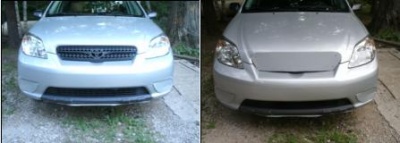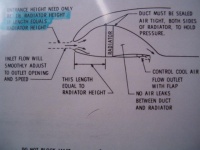Grill block partial or full
Introduction
Grill blocks have two purposes. The first is it cut down on aerodynamic drag by limiting the amount of air that enters the engine bay. The second is to allow the engine/transaxle (fwd vehicles) to warm up more quickly and retain more heat in the colder months by reducing excessive airflow through the engine compartment in colder months.
Grill blocks come in many forms, though most often they are made to be flush with the outside of the bumper for greatest benefit. Simply inserting a piece of cardboard in front of the radiator does not provide the same aerodynamic benefit.
While grill openings are usually oversized for "worst case" applications (towing a trailer through Death Valley with the A/C on), obviously care must be taken to monitor coolant temperature. If your cooling fan runs more after installing a block, you've gone too far. So, pay attention to your temp gauge and making your grill block easy to remove.
The idea is to block air from entering your engine compartment. This does two things, it reduces drag and helps the engine warm up faster.
This modification can cause the engine to get too hot as the grill block will block off air flow to the radiator. Some users have made actuated grill blocks which open when the radiator gets too hot. This reduces the use of the electric fan which draws power from the battery and therefore from the engine.
Contents
Korff's Minimum Opening for Cooling
Walter Korff (see book reference below) determined the minimum opening needed for efficient ram air cooling assuming sealed ductwork around the radiator, as follows:- Length from inlet duct to radiator should be equal to the radiator height.
- Inlet entrance height need only be 1/6th of the radiator height IF duct length is equal to radiator height
- Duct must be sealed airtight on both sides of radiator to hold pressure.
- No air leaks between duct and radiator.
However, most cars have too short a nose to have the 1/6th radiator size opening. Without extending the nose (such as the Aerocivic, the opening would need to be enlarged to compensate.
See the forum thread Ducting air from grille to radiator for more on this discussion
User experiences
Please enter your user name and any relevant data in the table
| User Name | Car Make, Model, Year | Cost of Mod | Time to Perform Mod | MPG Before Mod | MPG After Mod | MPG improvement guess | Instruction Link |
|---|---|---|---|---|---|---|---|
| Weather Spotter | Toyota, Matrix, 2006 | $4 (paint) | 2 hr | 45.02 | 45.73 | 1.55% (.71 MPG) ABA test data, top grill block only! Does not include warm up time savings | HOW I made a grill block Page |
| Weather Spotter | Toyota, Matrix, 2006 | $30 | 8 hr | 45.0 | 45.5 | 1.11% (.5 MPG) Instantaneous SG readout over many trips, lower grill block only! Does not include warm up time savings (25% faster) | Lower grill block that can open and close |
| Arminius | Honda, Civic LX, 2005 | 46.125 | 44.925 | 2.67% | Forum:Lower Grill Block 2005 Honda Civic | ||
| Soulster | Kia, Soul, 2010 | $0 | 1 hour | 33.97 | 34.32 | Upper grill block only 1.01% (.35 MPG) ABA testing | Soulster grill block data |
| euromodder | Volvo, V50, 2005 | $0 (tape) | <1 hour | 67.2 | 71.3 | 6% @ 43.5mph - FE never seen before - fairly consistent 0.2 L/100km (or better !) reduction at steady speeds compared to previously known FC | First real mod : grill block |
| cons | 04 Ranger | $1 | .5 hour | 30 MPG | 31 MPG | Upper grill block only 3.23% (1 MPG) tank to tank testing approximations, better results when upper grill was blocked, as opposed to when lower was blocked | |
| Echo-Francis | Toyota Echo 2005 | 10$ | 1 Hour | Not tested | Echo-Francis Upper & Lower Grille Block | ||
| H-Man | Geo Prizm 1994 | $0 | < 1 hour | 36.5 | 38.5 | 5.4% (2 MPG) gain in fuel economy due to the drive train actually warming up. Fan turns on at most once a day with upper grill block. |
Problems / Consequences of mod
- Higher engine temps, that might be good or not, so watch with ScanGauge.
- Over heating if you block all the air flow
- Extra electricity used to run the fan more. Connecting an LED in the cabin to the fan circuit can monitor the times that the fan is running.
Note: Partial grill blocks can be used if overheating occurs. This involves making a grill block that only partially stop air flow into the engine bay.
References
Forum discussion thread for this page
Forum thread links
- How to make an upper grill block (for a Matrix)
- How to make a lower grill block that can open and close (for a Matrix)
- Lower Grill Block 2005 Honda Civic
- Permanent Aluminum Grill Block and Belly Pan
- Soul Help (Grill block)
- 92-95 Civic Hatchback or Coupe Foglight Cover Blocks - by k.civic.f4i
- Prius grill block
- Arduino controlled automatically actuated grill block

